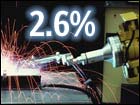Durable goods orders rise
January orders for long-lasting goods jump, but new home sales slump.
February 27, 2002: 10:59 a.m. ET
|
 NEW YORK (CNN/Money) - Orders for long-lasting goods rose last month in the United States, the government said Wednesday, a hopeful sign for the long-suffering manufacturing sector, but new home sales tumbled, conflicting with other data about a generally robust housing market.
NEW YORK (CNN/Money) - Orders for long-lasting goods rose last month in the United States, the government said Wednesday, a hopeful sign for the long-suffering manufacturing sector, but new home sales tumbled, conflicting with other data about a generally robust housing market.
The Commerce Department said orders for durable goods such as cars and computers rose 2.6 percent in January to $179.1 billion after rising a revised 0.9 percent in December. Economists surveyed by Briefing.com had forecast that durable goods orders would rise just 1.3 percent.
Excluding defense items, orders for goods meant to last longer than three years rose 2.3 percent in January after rising 0.7 percent in December. Excluding transportation items, durable goods orders rose just 1.3 percent after rising 0.4 percent in December.
"It's a sign that things have bottomed out, but we're not seeing a sharp turnaround in capital spending just yet," said Scott Brown, chief economist at Raymond James & Associates. "So it's encouraging, but it doesn't suggest anything more than a relatively muted and fragile recovery."
Separately, the Census Bureau said the pace of new home sales fell 15 percent in January to an annual rate of 833,000 units from a revised 966,000-unit pace in December. Economists surveyed by Briefing.com expected a pace of 940,000 units.
The drop contrasts sharply with Monday's report from the National Association of Realtors showing a 16.2 percent jump in January existing home sales to an annual rate of 6.04 million units, a record pace.
"Given how strong January existing home sales were, the surprisingly sharp decline in January new home sales may be more an adjustment to the robust December sales pace than the start of a weakening trend in housing," said Joel Naroff, chief economist at Naroff Economic Advisors.
"A rebound to solid levels would indicate today's report was not the start of a trend," Naroff added. "Another month near these levels would create some concern about the strength of the housing sector."
U.S. stock prices and Treasury bond prices initially rose Wednesday in response to remarks made by Federal Reserve Chairman Alan Greenspan before the House Committee on Financial Services. But stocks lost steam in the afternoon and finished mixed, with technology stocks dragged down by profit concerns about Cisco Systems Inc. (CSCO: Research, Estimates).
Greenspan told lawmakers that the economy seemed poised for a recovery and that gross domestic product (GDP), the broadest measure of economic strength, could be positive in the first quarter and grow between 2.5 percent and 3.0 percent in 2002.
But he also warned that the recovery could be less robust than those that have followed other recessions, due to a number of factors including an unemployment rate that could rise as high as 6.25 percent.
Greenspan also remarked on Wednesday's economic data, saying the durable-goods figure was better than he expected, but that it was too early to tell if it was the start of a trend. He also said he didn't think the 6-million-unit existing home sales pace in January was sustainable.
"The trend of existing home sales has been relatively flat at a reasonable high level for quite a long period of time, and if we can maintain that we are doing well," Greenspan said.
The Fed cut its target for short-term interest rates 11 times in 2001 to keep consumers spending and help set the stage for a recovery from a recession that some economists think began in March 2001.
After its policy meeting in January, the Fed decided to leave rates alone, indicating it was cautiously optimistic that a recovery was on the way. Economists and investors still are divided about the speed and strength of the recovery, but many seem to share the view expressed Wednesday by Greenspan.
The recession began with a freeze in business spending at the end of the spending boom of the late 1990s. Companies ended up with too many unsold goods on their shelves and too much unused machinery in their factories.
As a result, the manufacturing sector has been in recession for about 18 months, although it's been showing signs of improvement in recent reports from the nation's supply managers.
Particularly encouraging for industry and the broader economy, businesses have worked their inventories down to levels not seen since November 1999, meaning that, when demand picks up again, they'll be able to increase production and hire more workers.
But there's no guarantee that demand will pick up again. Among the factors necessary for an increase in business spending, according to Brown of Raymond James, are a turnaround in the slumping global economy and a recovery in corporate profits, which have shrunk for the past four quarters.
"The stock market has already priced in a good recovery in earnings," Brown said. "The risks are that if that the earnings rebound doesn't happen, we could end up slipping back."

|
| SPECIAL: |
|
|
|
|
|

|

